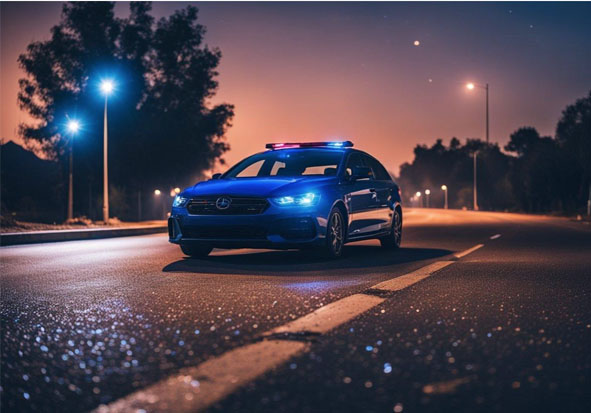How Long Does it Take for the Police to Find You After a Hit and Run?
By Space Coast Daily // July 29, 2025

In the aftermath of a hit and run, the urgency to locate the responsible party increases. Victims often wonder how long it may take for law enforcement to track down a driver who fled the scene. Generally, police can make significant progress within the first few hours, especially if there are witnesses, surveillance footage, or other evidence available.
Factors such as the availability of evidence, the location of the incident, and the resources of the police department all play a role in the timeline. Witness accounts can be invaluable, often leading to quicker identification of suspects.
Legal Framework
The legal framework surrounding hit and run incidents varies by jurisdiction, focusing on the responsibilities of drivers involved in accidents. The laws dictate the consequences of fleeing the scene, distinguishing between different types of incidents, including parked car scenarios.
Overview of Hit and Run Legislation
Hit and run laws are designed to address situations where a driver leaves the scene of an accident without providing contact information or assisting injured parties. Most jurisdictions classify hit and run offenses as misdemeanors or felonies, depending on the severity of the accident and injuries involved. Penalties may include fines, license suspension, and imprisonment.
In many areas, drivers involved in an accident are required to stop, exchange information, and render aid if necessary. Failure to comply can result in serious legal repercussions.
Specifics of Parked Car Hit and Run Laws
Parked car hit and run laws specifically address incidents where a vehicle is struck while parked, often leading to different legal considerations. In these cases, the responsible driver must leave information for the car owner or report the accident to local authorities.
Fines for leaving the scene can be imposed, which are sometimes less severe than those associated with accidents involving injuries.
Impact on Victims
The aftermath of a hit and run can leave victims feeling vulnerable and uncertain. Knowing how to respond can significantly affect their experience and recovery.
Steps to Take Following a Parked Car Hit and Run
If someone hits a parked car and leaves, the victim should take immediate action. First, they should gather evidence by taking photographs of the damage, the surrounding area, and any visible debris.
Next, contacting the local police to file a report is essential. This documentation will be crucial for insurance claims and potential legal actions.
Victims should also collect witness statements if possible, as these can provide additional details and help identify the responsible party. Finally, reporting the incident to their insurance company as soon as possible will start the process of recovery and help assess coverage options.
Navigating Insurance Claims
When dealing with insurance claims after a hit and run, victims need to understand their policy details. Collision coverage may cover damages if the responsible driver is unidentified.
It is important to provide all gathered evidence to the insurance company, including police reports and photographs. Timely submission of such documents will help expedite the claims process.
Victims should also maintain records of all communications with their insurer. Furthermore, keeping track of any repair estimates is vital for ensuring they receive appropriate compensation related to the accident.
Police Investigation Process
The police investigation process for hit-and-run incidents involves critical steps to gather evidence and track down offenders. This ensures a thorough approach to resolving these cases efficiently.
Initial Response and Evidence Gathering
When a hit-and-run is reported, police respond rapidly to the scene. The first priority is to assess any injuries and provide medical assistance if needed. Officers then secure the area to prevent contamination of evidence.
They gather essential details, including witness accounts and photographs of the scene. Key evidence can include:
- Vehicle debris: Fragments from the fleeing vehicle can help identify its make or model.
- Surveillance footage: Cameras nearby may capture the incident or the vehicle’s escape route.
- Witness statements: Accurate accounts provide crucial insights into the incident.
Documentation of all findings is vital.
Tracking Down Offenders
Once evidence is collected, the police begin tracking the offender. They analyze the gathered information to determine potential suspects.
Key tactics include:
- License plate recognition: If the license plate is captured, authorities can quickly access vehicle registration details.
- Community outreach: Police often release descriptions of the vehicle and suspect to the public, encouraging tips.
- Regional databases: Officers utilize databases to match evidence, such as paint samples or distinctive damage.
The efficiency of this phase is crucial. Time is often of the essence when locating a suspect after a hit-and-run incident.
Preventative Measures
Taking steps to prevent hit-and-run incidents can significantly reduce their occurrence. By focusing on improving parking safety and fostering community awareness, individuals can create an environment that discourages reckless behavior.
Improving Parking Safety
Effective parking safety measures can minimize the chances of accidents. Secure design principles should be enforced in parking areas.
- Lighting: Adequate lighting is crucial. Well-lit areas deter potential offenders and help witnesses identify vehicles involved in incidents.
- Surveillance Cameras: Installing cameras can provide vital evidence. Video footage aids in identifying offenders and can be a deterrent.
- Clear Markings: Properly marked parking spaces and directional signs reduce confusion. This can help prevent accidents in crowded areas.
- Barrier Usage: Barriers or planters can protect parked cars. They serve as physical deterrents against collisions.
Community Awareness and Reporting
Community involvement is essential in addressing hit-and-run incidents. Encouraging vigilant behavior can lead to faster responses when incidents occur.
- Educational Campaigns: Local organizations can hold awareness programs. These programs should focus on the consequences of hit-and-runs and the importance of responsible driving.
- Reporting Systems: Establishing an easy-to-use reporting system allows citizens to report suspicious behavior. Quick reporting can lead to timely police intervention.
- Neighborhood Watches: Forming watch groups encourages residents to look out for each other. Active participation can deter reckless driving.
- Public Meetings: Communities can hold forums to discuss local safety concerns. Engaging in dialogue fosters a sense of shared responsibility for public safety.
Through these initiatives, communities can decrease the likelihood of hit-and-run incidents and enhance overall safety.












